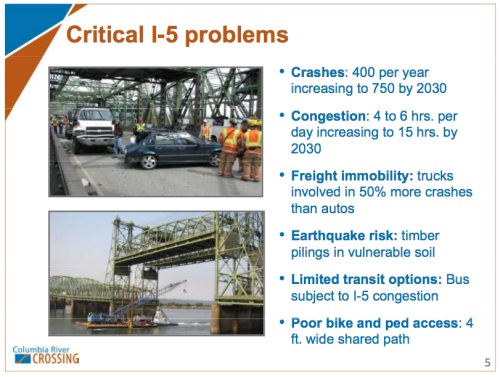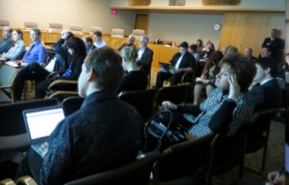HB 2800, a bill that would declare it’s in the state’s interest to “undertake” the Columbia River Crossing project (now referred to as “the I-5 bridge replacement project”) got a public hearing in Salem yesterday. We also heard about a new “bipartisan coalition” that has been formed in opposition to the project.
The hearing yesterday lasted well over four hours and took place in front of a 16-member Joint Committee made up of state legislators. The legislators heard testimony in support of the project from Governor Kitzhaber and heard from dozens of citizens who showed up at the Capitol to share their opinions. From reports we monitored, the crowd was very large, spilling over into two additional rooms in addition to the main hearing room.
According to people that made the trip to Salem, the vast majority of those who testified were opposed to the project (one source said it was 90% in opposition). But the project had a huge boost at the start of the hearing with Governor Kitzhaber, both Co-Chairs of the committee, the Chair of the Oregon Transportation Commisssion, and the ODOT project manager all setting the tone early on. The first two citizen speakers from Hayden Island also gave strong support for moving forward.
The main themes from these boosters of the project were timing (both for funding and to save the bridge from falling down in an earthquake) and safety. One of the committee Co-Chairs (I didn’t get the name) said after a recent meeting with federal representatives he, “Came away convinced that the money is there if we move forward quickly.” Co-Chair Cliff Bentz (R-Ontario) cited the “400 accidents per year” on the bridge and said freight movement is a key concern for his district (which is 375 miles away from the project).
Then, in a strange move that seems to underscore the outdated principles this entire project is based on, ODOT showed a 2002 video explaining the need for highway expansions and a new bridge on I-5 between Oregon and Washington.
Here are a few images from a slide presentation given by ODOT to make the case for project:


Seated in front of the committee, Governor Kitzhaber also struck a sense of urgency. He said, “It is time to build a bridge” and added that the project has been “analyzed, criticized, downsized and looked at at every possible angle (critics refute that claim).” Kitzhaber told legislators that the CRC is a “construction ready project” that it’s needed to alleviate “concerns about congestion from business and community leaders” and that it will “increase mobility and the transportation of goods throughout Oregon.”
On the timing aspect, Kitzhaber made it seem like the project enjoys broad support and that all that’s missing is a funding commitment from Oregon. “We have reached a point of opportunity and some significant urgency,” he said, “We have support of everyone… If we are able to move forward by making a commitment in resources.”
“If we have as much misfortune in building this project as we have had in planning it, or if the other funding sources fall through, and the cost skyrockets, what then? What transportation projects in your districts will you be willing to cut? What programs will you be willing to cut?”
— Testimony from Peter Welte
If Oregon doesn’t move fast, Kitzhaber and others said, the feds will never fund the project. It’s now or never (which is the same thing they’ve been saying for over five years). “If we fail to act, other projects will move up in the queue.”
In his opening remarks, Oregon Transportation Commissioner Chair Pat Egan acknowledged that funding the CRC will impact other state transportation projects. “So we’re keen on finding new revenue.” He estimated the debt service would total $27 million per year on a 30-year time horizon. He said that money could be raised with a one-cent per gallon increase to the gas tax or a $5 per vehicle in registration fees.
[Lack of money to pay for Oregon’s share of the project is likely to emerge as a major sticking point. Biking and walking advocates are especially concerned because debt payments will be pulled directly from a funding source that usually goes to active transportation projects. Sources close to ODOT and PBOT say they’re worried that HB 2800 mandates that bond repayments come from state transportation funds — not the state’s general fund like a previous CRC bill called for. This means ODOT will pull from their “flexible” funds that have historically paid for biking and walking projects throughout the state (stay tuned for more on this).]
Almost immediately after opening statements, the committee began asking tough questions.
Sen. Fred Girod (R-Stayton) seemed annoyed that ODOT Director Matt Garrett wasn’t present to answer questions. He wondered, “Are we robbing Peter to pay Paul? $450 million [Oregon’s share of the project] isn’t a small amount of money.”
Rep. John Davis (R-Wilsonville) asked “Why this bridge? Why now? We have alternatives… What would happen if we just scrap this?” According to one source, that comment led to cheers in the meeting room.
Rep. Julie Parrish (R-West Linn/Tualatin) asked about cost overruns. “What if there is a cost overrun?” she wondered, “I don’t have confidence in the state… I have yet to see big projects that we get accomplished that don’t have overruns.”
The ODOT project manager had responses to these questions — repeating that they hope to find a new revenue stream in the coming years, that they vetted all the design options, and that they are confident in their cost estimates (ODOT’s Kris Strickler said they think they’ll complete it under the estimated cost).
The question is, will committee members and other legislators who will ultimately decide HB 2800’s fate like those answers enough to vote for the bill? Or will legislators take time to understand the grave concerns with this project being aired by a growing number of their constituents?
Washington County resident and board member of Bike Walk Vote Peter Welte was one of those who testified in opposition. He voiced concerns that this project would put funding for other projects at risk. He also pushed back on three common arguments for the project: saying the bridges aren’t in as bad of shape as ODOT says; that ODOT can’t pay for it; and that it won’t “fix congestion.”
Below is a particularly effective passage from Welte’s remarks:
“If we have as much misfortune in building this project — the DOTs have spent over $160 million on a jobs program for highly paid consultants, without laying a brick — as we have had in planning it, or if the other funding sources fall through, and the cost skyrockets, what then? What transportation projects in your districts will you be willing to cut? What programs will you be willing to cut?”
One issue I see emerging is that electeds feel opposition exists only on the extremes. Rep. Parrish tweeted to us that the opposition to the CRC is “fascinating” and that “folks on the far left and the far right are united.” Politically, that’s a dangerous place for the opposition to occupy.
Feeding that narrative is a new coalition in opposition to the project that was announced yesterday. This coalition of very strange bedfellows includes: John Charles of the Cascade Policy Institute; Steve Cole with the Northeast Coalition of Neighborhoods; Karla Kay Edwards with Americans for Prosperity-Oregon; Mara Gross of the Coalition for A Livable Future, and Jason Williams with the Oregon Taxpayer Association. The new group’s number-cruncher is none other than Joe Cortright, President and Chief Economist at Impresa Consulting.
Despite reasonable concerns and seemingly obvious problems with this project, conventional wisdom seems to be that HB 2800 is headed for passage. The political power behind it is daunting (“It has been greased,” said anti-CRC activist Ron Buel during his scathing testimony that called out many of the project’s lobbyists and campaign funding ties); but popular activism against it is gaining steam. If those who oppose this project hope to have a fighting chance to stop, they need a high-profile, moderate and respected voice to emerge. Would even that be enough to stop this steamroller? Stay tuned.
This bill will get another public hearing on Monday (2/18). There’s a citizen’s group already organizing carpools if you’d like to attend.
More coverage of yesterday’s hearing via The Oregonian. You can also read a live-blog from Mismanaging Perception.

